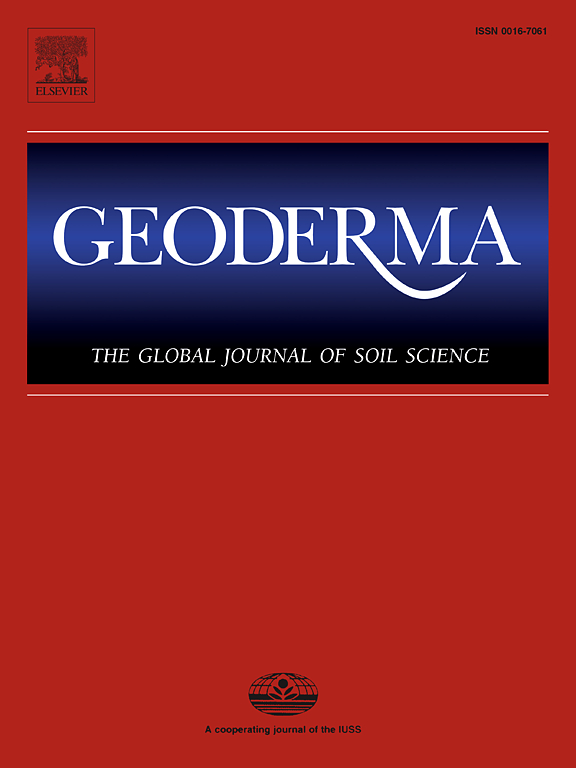Effects and mechanisms of warming on the relationship between soil organic matter degradation and methylmercury production in Hg-contaminated soil
IF 5.6
1区 农林科学
Q1 SOIL SCIENCE
引用次数: 0
Abstract
The degradation of soil organic matter (SOM) is an essential process that not only drives the production of greenhouse gases (GHGs) but also influences the environmental fate of pollutants, such as mercury (Hg), specifically methylmercury (MeHg) production. However, the relationship between these processes and their response to warming remains unclear. To address this gap, we conducted a 60-day microcosm incubation period using mimic-contaminated soils with varying Hg levels to investigate the effects of warming on SOM degradation and MeHg production. These results indicate that Hg stress does not significantly affect GHG production but increases the temperature sensitivity (Q10) of SOM degradation. This implies that warming increases the feedback of carbon release in contaminated soil, particularly when considering seasonal temperature dynamics or prospective global warming scenarios. Additionally, warming can significantly promote GHG production. However, warming did not significantly affect MeHg production, except in the high Hg treatment (i.e., HgH), due to minimal changes in the Hg fractions that regulate MeHg production. Furthermore, regardless of temperature changes, the relationship between GHGs and MeHg shifted from positive to negative as Hg levels increased. This highlights the need to balance carbon emission reduction and pollutant treatment policies to effectively reduce risks in contaminated sites. In conclusion, in terms of the current development of C management strategies for mitigating climate change and enhancing carbon sequestration, the turnover of SOM and its ecological implications for contaminated soils should be revisited. Future research should incorporate contaminated soils into global carbon models to improve SOM turnover predictions in terrestrial systems.
变暖对汞污染土壤有机质降解与甲基汞产生关系的影响及机制
土壤有机质(SOM)的降解是一个重要的过程,不仅驱动温室气体(ghg)的产生,而且影响污染物的环境命运,如汞(Hg),特别是甲基汞(MeHg)的产生。然而,这些过程与它们对变暖的反应之间的关系仍不清楚。为了解决这一差距,我们使用不同汞水平的模拟污染土壤进行了60天的微观孵化期,以研究变暖对SOM降解和MeHg生成的影响。这些结果表明,汞胁迫对温室气体的产生没有显著影响,但增加了SOM降解的温度敏感性(Q10)。这意味着变暖增加了污染土壤中碳释放的反馈,特别是考虑到季节性温度动态或预期的全球变暖情景时。此外,变暖可以显著促进温室气体的产生。然而,除了高汞处理(即HgH)外,增温并没有显著影响甲基汞的产生,因为调节甲基汞产生的汞组分变化很小。此外,无论温度如何变化,随着汞含量的增加,温室气体和甲基汞之间的关系由正向负转变。这凸显了需要平衡碳减排和污染物处理政策,以有效降低污染场地的风险。综上所述,就目前减缓气候变化和加强碳固存的碳管理策略而言,应重新审视SOM的周转及其对污染土壤的生态影响。未来的研究应将污染土壤纳入全球碳模型,以改善陆地系统中土壤有机质周转的预测。
本文章由计算机程序翻译,如有差异,请以英文原文为准。
求助全文
约1分钟内获得全文
求助全文
来源期刊

Geoderma
农林科学-土壤科学
CiteScore
11.80
自引率
6.60%
发文量
597
审稿时长
58 days
期刊介绍:
Geoderma - the global journal of soil science - welcomes authors, readers and soil research from all parts of the world, encourages worldwide soil studies, and embraces all aspects of soil science and its associated pedagogy. The journal particularly welcomes interdisciplinary work focusing on dynamic soil processes and functions across space and time.
 求助内容:
求助内容: 应助结果提醒方式:
应助结果提醒方式:


